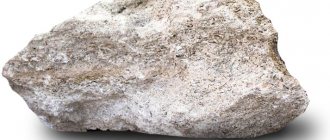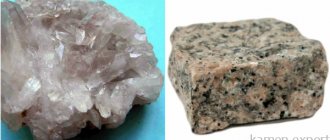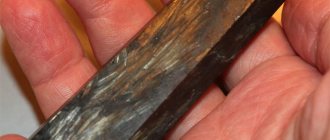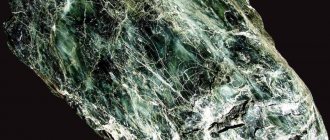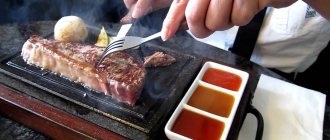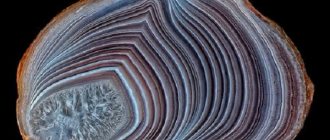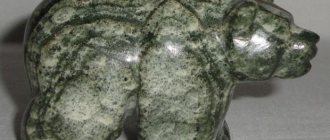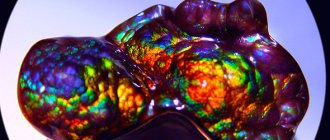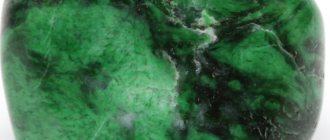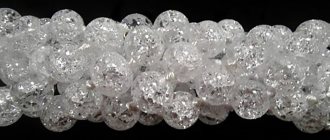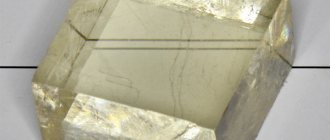To tell the truth, several years ago I didn’t even know about the existence of dunite. Quite by accident I came across an advertisement for stones for a sauna stove. Among others there was a dunite.
“We need to find out more about the stranger,” I decided and began to collect information about this stone.
The matter turned out to be quite difficult. Most bath forums and websites don’t even ask what kind of stone this is.
Yes, there are bathhouse attendants who ask about how the blower behaves in a stone oven, how long it takes to heat up and how long it stays warm. What is its service life for its intended purpose?
I did not find direct answers to questions about whether stone is suitable for a sauna stove. I couldn't find a single review of the stone. No one shares personal experience of using dunite.
I concluded for myself: a mysterious, enchanted and rare stone is blowing.
Although one can argue about rarity...
History and origins
The dunite stone gets its name from New Zealand's Dun Mountain, where it was discovered.
Being a deep-seated igneous rock, dunite is formed at the initial stages of lava differentiation, when olivine and, in some cases, chromite crystallize from the melt. Settling at the bottom of the magma chamber, the mineral forms an almost monomineral rock.
Mineral - Dunite
The main component of dunite is olivine - it consists of 85-90% of it, which determines the color of the stone, which varies from dark gray to almost black and from yellowish-green to dark green.
Under the influence of weathering, olivine, which is part of this rock, is transformed into serpentine and partially into magnetite. Dunite can rarely be found in an unaltered form: as a rule, it is largely serpentinized or even completely transformed into a serpentine. Chromium and magnetic iron ores are also often found in dunite.
Typically, dunite is found in the lower layered horizon of the main intrusions.
Chemical composition
Chemical theoretical composition: MgO - 69.12; H2O - 30.88; Mn and Fe partially replace Mg; When Mg is replaced by Mn, no distortion occurs in the structure. In small quantities, Mg is also replaced by Zn (3.67% ZnO in manganbrucite from Franklin). Sometimes CO2 content is noted, which is apparently due to the presence of carbonate impurities. In brucite from the chromite-bearing massif of Southern Iraq (Bashkiria), Ga (0.0003%) was spectroscopically identified.
Varieties
Nemalite - nemalite - fine-fibrous. The name comes from the Greek “nema” - thread (Natel, 1821). Synonym of Nematolite - nematolite (Hinze, 1915). The fibers are elongated in parallel (0001). There are two types of nemalite: 1 - the direction of fiber elongation completely coincides with the a-axis (nemalite from Asbestos and Luoyang); 2 - the direction of elongation forms an arbitrary angle with a (nemalit from Lancaster and Hoboken counties). Colors are white, cream, emerald green, teal and black. The luster is glassy or silky. Elongation (—). Usually biaxial. The composition corresponds to the formula of brucite. Fersman distinguished between nemalite and ferronemalite - ferronemalite - with a FeO content of 5-7%.
Nemalit
Ferrobrusite - ferrobrucite (Lacroix, 1909) contains a significant amount of Fea+, replacing Mg (up to 36% FeO, according to Betekhtin). In appearance, in a fresh state, it is completely similar to brucite. In the light it turns brown and splits along cleavage planes. In the weathering zone it acquires a golden-brown color and turns into pyroaurite. It was observed in association with brucite (in zonal intergrowths) and with magnesium hydrocarbonates in cracks among highly serpentinized dunite, sometimes in chromite bodies. Iron-rich varieties were found in Russia in the Urals in platinum-bearing chromite deposits in the Nizhne Tagil dunite massif (according to Betekhtin, 1950). It is possible that collingite or its mixtures are sometimes mistaken for ferrobrusite.
Manganbrucite - manganbrucite (Igelström, 1882) contains a significant amount of Mn2+, replacing Mg. Synonym for manganobrucite. The mineral from Franklin has a ne of 1.60; no = 1.59. In air it quickly turns brown and black. Found in association with hausmannite and other minerals in manganese ores of Jacobsberg (Värmland, Sweden) and zinc ores of Franklin (New Jersey, USA).
Trigonal syngony.
Class. Ditrigonal-scalenohedral D3d - 3m (L33L23PC).
Crystal structure
The structure is layered, similar to the structure of CdJ2; the role of an anion is played by the (OH)1- group with an ion radius of 1.33 A. Such groups are arranged according to the principle of the closest hexagonal packing. Each layer consists of two parallel (0001), flat sheets folded by groups (OH), and a layer of Mg atoms located between them, occupying all the octahedral voids between the sheets (OH); each Mg atom is located between six (OH), linking three (OH)1- of one sheet with three (OH)1- (rotated by 180°) of the other sheet. Perfect cleavage passes between triple layers, linked to each other by weak residual bonding forces.
Nemalit
Main forms:
What does dunit look like?
Dunit does not shine with unprecedented beauty. It has no special features in its color scheme.
If you are not a geologist or an expert on stones, then it will be quite difficult to distinguish dunite among the general rock mass. For me, it's stone and stone. I didn't find anything special in it.
The color palette is large: from green to black. Color from light to dark tones. Transparent dunite does not occur in nature.
The stone has a medium-grained massive structure. In rare cases it may be coarse-grained.
Color
The color of this breed can vary widely from very light to very dark tones. Shades of green are common. You can also find black dunite. All varieties are completely opaque.
Dunite (stone). By Pikarl at de.wikipedia, from Wikimedia Commons
Characteristics of the stone
Let's find out the origin of dunite. It is formed deep underground from the transformation of magma. Its deposits are located below the earth's crust, which means the mineral is completely radiation safe. After all, it is known that all unstable atoms gravitate towards the surface of the earth.
Dunite was first discovered in New Zealand near the Doon Mountains. That's where its name came from. It belongs to the ultrabasic stones. This means that it contains between 30 and 45% silica , so it is great for a lot of heat-cool cycles without releasing toxic silicon compounds.
Chemical composition
Dunite contains impurities, their amount will vary depending on the place where the stone is mined. The approximate mineral composition would be:
- MgO – 40–52%;
- SiO2 – 36-42%;
- FeO – 4–5%;
- Fe2O3 – 0.6–8%;
- Al2O3 – 3%;
- CaO – 0.5-1.5%;
- Na2O – 0.3%;
- K2O – 0.25%.
When exposed to high temperatures and carbon dioxide, olivine turns to silica, which turns dunite into a more brittle stone. In order to distinguish olivine from silica, just try to scratch them with a knife. The first of them will remain unchanged, while the second will remain a mark.
Mineral composition
Dunite can be 90 percent or more composed of the mineral olivine , with its only difference from olivinite being the presence of chromite instead of magnetite . Dunite also contains pyroxenes and, occasionally, hornblende.
Dunit stone for baths is sometimes sold as part of a mix (mixture) with other types of stones
The structure of dunite is either fine or medium-grained.
Weathering and exposure of olivine to hot groundwater leads to its serpentinization , in which it transforms into the softer mineral serpentine . It was already mentioned above that dunite is the basis for the formation of soapstone (this also applies to other representatives of its family).
Interesting: Optimal bath sizes: how to choose yourself
Due to its deep formation, dunite rarely appears on the surface, and if it does, it quickly undergoes weathering and metamorphism , which worsens its properties. This makes it quite rare. When buying a sand and gravel mixture, you can’t expect to find it there.
Sometimes there is a certain confusion in the names, when the box contains dunite , but the box says “ peridotite ”. In fact, there is no mistake here.
IMPORTANT! When dunite occurs together with other members of the peridotite family, such as harzburgite and lherzorite, they are not separated (they have very similar properties) but are sold as peridotite .
Physical properties
| Characteristic | Meaning |
| Density | 3000–3300 kg/m2 |
| Specific heat | 0.7-0.9 kJ/kg*K |
| Thermal conductivity | 1.2-2.0 W/m*K |
| Thermal diffusivity | 7.2–8.6 m2/s |
| Melting temperature | over 1200 C |
From the physical characteristics we can conclude that the stone heats up well and quickly and conducts heat, and does not collapse under the influence of high temperatures.
However, its cooling occurs just as quickly due to its low heat capacity.
Peculiarities
Dunite has a grainy texture. Most often it is fine, but there are stones with medium and coarse-grained texture. The color scheme is not very diverse. The mineral is found in gray, brown, green and black shades. Note the inclusions of gray or metallic color, which indicates the presence of sulfur in the rock. When they come into contact with high temperatures and high humidity, sulfuric and sulfurous acids begin to be released, the vapors of which irritate the mucous membrane of the eyes and respiratory tract, and even cause burns.
If such inclusions are insignificant, then after several heating-cooling cycles all the sulfur will completely disappear and the sauna will become safe. But if there is a large accumulation of sulfur, it is better to throw away the entire stone.
Spreading
In Russia there are deposits in the Baikal region, the Urals and the Caucasus. In the territory of the former Union it is found in Central Asia and Ukraine.
Ural dunite contains predominantly the mineral olivine and some oxides of iron, chromium and aluminum. The closest analogue of dunite would be olivinite, which differs for the better because it contains less serpentine .
Physical properties
Characteristic
Meaning
From the physical characteristics we can conclude that the stone heats up well and quickly and conducts heat, and does not collapse under the influence of high temperatures.
However, its cooling occurs just as quickly due to its low heat capacity.
Advantages and disadvantages
The advantages of dunite include the fact that it:
- heats up instantly and releases heat evenly without expanding;
- has pronounced fire-resistant properties, can withstand temperatures up to 1200 °C;
- does not emit odor when heated;
- protects against poisoning by interacting with carbon dioxide.
Among the disadvantages it is worth noting that:
- dunite does not have a very impressive appearance;
- does not have a long service life;
- over time it turns into serpentine;
- possible presence of sulfur in the composition;
- it is difficult to find an original product on the market;
- small size in most cases.
Implementation of the field development project
Everything would be fine, a large deposit has been found, all that remains is to start developing it. All dunite mining projects were agreed upon back in the 2000s, and in 2007, the Limited Liability Company “Dunites of the Northern Urals” received a license for this type of work at the Yovskoye deposit for a period of up to twenty years. In preparation for the implementation of the project, investors were found who were ready to invest one hundred million rubles in the development of this field. According to the plan, the company was to organize dunite mining within four years, thereby ensuring the export of the mineral and jobs.
When implementing the project, production was planned in the following areas:
- foundry sands;
- crushed dunite;
- sawn stone;
- ceramic filler for oil and gas production - propane.
Since the deposit geographically belongs to the territory of the urban district of Karpinsk, it was planned to launch all production there and then. To do this, it was necessary to use the building of a former cotton spinning factory, it was only necessary to build a magnesium plant, which would thereby provide 1,800 additional jobs.
Application area
The stone has applications in various industries. It is used as a filler in sandblasting machines because it does not harm human health, unlike quartz, which is classic for such machines, and can cause lung pathologies.
Some brightly colored specimens are used to make souvenirs. Dunite is also used in construction as a fire-resistant material. High quality samples serve as raw materials for the production of facing tiles for rooms with high humidity. Dunit for a bath is a budget option for heat-resistant masonry. Durable material can be placed at the bottom of the masonry, where it will be in contact with the fire.
The magnetite variety is used in agriculture. Crushed pebbles are added to acidic soils. Mixing with the soil, the additive restores soil contaminated with calcium salts, which improves fertility. Ilmenite samples are used in the production of ceramic products that are resistant to high temperatures. The rock is added to mixtures from which cement and concrete are produced.
Interesting: Impregnation for the inside of a bath - how to choose a stain, varieties
How to choose the right dunite for use in a bathhouse
Dunite is an inexpensive stone. However, unscrupulous sellers may sell serpentinite or clinopyroxenite under this name. The first is dunite that has undergone a serpentinization process. If you put it on a heater, it will turn into brown blocks that do not retain heat well.
When heated, clinopyroxenite releases substances that form harmful compounds when interacting with oxygen. Staying in a bathhouse in the construction of which this material was used can lead to poisoning.
In order to choose the right material, you need to adhere to the following recommendations:
- When purchasing, you need to touch the stone with a sharp object. There will be a scratch on the serpentine.
- You need to carefully examine the pebbles for the presence of sulfur inclusions. Sulfides look like small spots and veins of yellow, gray-golden, gray color with a metallic sheen. When heated, these compounds will release sulfur, which will combine with water vapor to form an acid. If stones have more than 5% harmful inclusions, the stones cannot be purchased.
- Should be checked for strength. A high-quality sample will not crumble after a strong blow with a hammer.
- It is necessary to select specimens that do not have cracks. Cracked dunite will quickly deteriorate when heated.
Price
Dunite is a relatively inexpensive stone. Its cost on the market ranges from 20 to 55 rubles. for 1 kg. Dunite for baths is usually sold processed and packaged in boxes of 20 kg, which ensures ease of transportation.
Important! You should not chase the price, as there is a risk of running into a fake, which releases sulfur when heated, resulting in the formation of sulfuric acid, which can be harmful to health.
Also, under the guise of dunite, pyroxenite is often sold, which is easier to mine and therefore its cost is lower, but it can crack under the influence of high temperatures and release toxic substances.
How to place dunit in the oven
After purchase, any stone must be washed and carefully inspected. Check the external condition. If there are cracks, stones cannot be used.
Before placing it in the oven, the dunite must be calcined. The stone may contain inclusions, specks and veins of metallic luster.
If there are few of them, then after several calcinations they will not cause harm.
When there is a lot of metallic shine, throw away the stone.
Dunite can be laid in the oven as the first layer. It withstands open fire well.
Another issue is that the appearance of the stone is rather inconspicuous. For a closed stone backfill - an ideal option.
In an open heater, dunite can be mixed with more beautiful stones.
What can be replaced
High-quality dunite can last 5-6 years. It does not emit foreign odors when heated, so it is suitable for people with a sensitive sense of smell. However, the stone does not stand out for its aesthetic properties; sometimes it is preferred to replace it with rose quartz. This mineral is able to retain heat and looks more attractive. However, it serves less well than plutonic rocks, like clinopyroxenite and dunite.
The table describes other stones that can be used when arranging baths and saunas.
| Name | Description and benefits | Flaws |
| Gabbro-diabase | Volcanic rock of gray color. Does not emit harmful impurities during heating, retains heat for a long time, low cost. | Short-lived. Service life – 2 years. |
| Soapstone chlorite | Stones of gray shades with light stripes and inclusions. It has a high heat capacity and does not form odors when heated or wet. | It is dusty and contains a small amount of moisture, which leads to gradual destruction in a bathhouse. |
| Jade | Green ornamental stone. It retains heat well, has an attractive appearance, and has medicinal properties. | It has a high cost. |
| Porphyrite | Available in grey, black or green. May contain impurities that create a pleasant aroma when exposed to high temperatures. | Begins to deteriorate after 2 years of intensive use. |
| Rodingitis | It has a bluish, greenish, grayish tint. Heats up quickly and gives off heat for a long time, does not change when heated and cooled, durable. | More expensive than dunite, iron oxides are often found on the surface. |
| Nephritis | Green mineral. It looks attractive, has healing properties, and retains heat for a long time. | Expensive. |
| Wax jasper | A stone with an uneven orange tint. It is not afraid of exposure to hot steam and has a magical and healing effect. | High price. |
| White quartz | Opaque white mineral. When heated quickly, it produces ozone. | They often sell low-quality copies that are destroyed. |
| Chromite | Dark colored material. It has high density and resistance to mechanical stress. | With prolonged use, it loses its original attractive appearance. |
Interesting: Building a panel bathhouse with your own hands: step-by-step instructions from the very first steps
Links
- Dunit // Great Soviet Encyclopedia: [in 30 volumes] / ch. ed. A. M. Prokhorov. — 3rd ed. - M.: Soviet Encyclopedia, 1969-1978.
- Edited by K. N. Paffengoltz and others.
Dunit // Geological Dictionary: in 2 volumes. - M.: Nedra (Russian). - 1978. // Geological Dictionary: in 2 volumes. — M.: Nedra. Edited by K. N. Paffengoltz et al. 1978. - GeoWiki article
| Great Catalan Great Russian Britannica (online) Modern Ukraine |
This page was last edited on April 8, 2021 at 11:44 am.
InterpretationTranslationDunit Dunit
- ultrabasic plutonic rock, normal series of the peridotite group. Named after the Doon Mountains, New Zealand. More than 90% consists of olivine with an admixture of chromite, which differs from olivinite, which contains magnetite instead of chromite. There are chromite dunite (70% olivine, 30% chromite), ilmenite dunite (60% olivine, 36% ilmenite, the rest are accessory minerals) and magnetite dunite (70% olivine, 30% titanomagnetite. Clinopyroxene may be present in small quantities in dunites, orthopyroxene, plagioclase, etc.
Color black, dark and light green. Wed. chemical composition (%): Sio2 40.49; Thio2 0.02; Al2O3 0.86; Fe2O3 2.84; FeO 5.54; MnO 0.16; MgO 46.32; CaO 0.70; Na2O 0.10; K2O 0.04; P2O5 0.005; H2O 2.88. The density of dunite is 3.28, Young's modulus 0.89-1.95xx.105 MPa, shear modulus 0.476-0.706xx.105 MPa, Poisson's ratio 0.16-0.40. Dunites are common in dunite-harzburgite and dunite-clinopyroxenite-gabbro complexes of folded areas, on platforms - in layered intrusions and ring ultrabasic alkaline complexes. The classic area of development of dunite is the Middle and Southern Urals.
Reviews
Reviews from real customers are very contradictory. Some say they are very pleased with the purchase. The stone perfectly withstands a large number of heating-cooling cycles, does not crack, and does not emit unpleasant odors. They note an improvement in health after going to the bathhouse where dunite is used.
Others note that the stone quickly collapsed, when heated, it forms a porous structure, and when moisture gets on it, it absorbs it. Most likely, this is due to the fact that a low-quality stone was used, which quickly turned into serpentinite.
About the disadvantages
It's time to talk about the unpleasant. We also talked in other articles about the fact that sulfides are the reason why many users speak unflatteringly about Karelian stones (here we are talking not only about dunite , but also about gabbro , and porphyrite , and other stones mined there). However, it cannot be said that sulfide admixture is a problem only in Karelian deposits. They are found quite often in deep igneous rocks everywhere.
IMPORTANT! How does sulfide behave in a bath? Under the influence of high temperature in the presence of air, it releases sulfur, which turns into oxides, and under the action of water vapor, sulfur oxides immediately become acids . Tiny drops of acids (sulfuric and sulfurous) enter the nasopharynx when breathing, burn it, causing soreness and coughing. The eyes also suffer - a sharp pain is felt in them. The more sulfides in the stones, the more dangerous they are for vapers.
Compared to acid, another drawback will seem trivial: dunite is not found very often on the surface, so it is considered relatively rare, and this is reflected in its price .
serpentinization, which has been mentioned more than once, is also one of the disadvantages of the stone.
Development of tourism near the Yovskoye field
Everything would be fine, but the Yovskoye deposit is located next to Mount Konzhakovsky Kamen, one of the highest peaks of the Ural Mountains (1569 m). The area of this mountain is included in the widespread tourist route “Konzhakovsky massif”, consisting of the Serebryansky and Konzhakovsky ridges. The source of the following rivers begins from these slopes: Katysher, Konzhakovka, Serebryanka, Job, Poludnevaya. All these rivers flow into the Lobva River, which belongs to the Arctic Ocean basin.
On June 29, 1996, the marathon race on Mount Konzhakovsky Kamen took place for the first time; fourteen people took part in it. Now it has become a tradition, every year on the first Saturday of July the Konjac mountain marathon takes place, in which world champions, European champions, Russian champions, climbers who conquered mountains such as Everest and Makalu, Lhoztse and Zhannou took part, and there were also representatives sports such as skiing, biathlon, speed skating, hockey, triathlon, boxing, wrestling, swimming, mountain tourists and simply lovers of an active lifestyle. In 2015, one thousand eight hundred and eighty-four residents from countries such as Kenya, the Netherlands, Germany, the Czech Republic, Belarus, Kazakhstan and Russia took part in the marathon. In addition, 3 residents of the country of Singapore walked most of the marathon distance; they took part without registration. One thousand six hundred twenty-six people covered a distance of thirty kilometers.
Interesting things about the stone
- The best variety of dunite for use in a bathhouse is Ural. The stone should be placed on the bottom of the oven under layers of other stones used for therapeutic purposes. This increases the overall healing effect, since dunite heats up quickly and retains heat for a long time. Use with white quartz and Himalayan salt promotes air ionization and creates a cozy microclimate in a home bath.
- The thermal stability of dunite is due to the low content of volatile substances in the composition. When heated, the stone can only lose 1.5% of its mass, so it does not crack.
- Dunite can be ground quite easily into sand. In this case, olivine grains take on the role of grains of sand.
- In past times, mineralogists believed that dunite could contain diamonds and platinum. There is unconfirmed evidence that such isolated finds have taken place, but over the past decades, despite intensive searches, such a breed has not been found.
- A separate advantage of the stone is its beautiful and unusual texture. Dunite has a huge number of shades and contains a variety of decorative inclusions, which naturally finds application in design.
General description of the mineral
Stone originates at depths and comes out during volcanic eruptions. It is collected in mountainous areas, further from civilization. The mineral was first found in New Zealand under Mount Doon. Because of this, he was named Dunit. It is mined all over the world, for example, in the Russian Federation it is brought from the Urals.
Externally, Dunite for a bath is not attractive: the rocks can be of different colors from gray to dark green with multi-colored inclusions. Despite the lack of aesthetics, in terms of quality characteristics this is the best stone - it retains heat for a long time and does not evaporate toxins.
